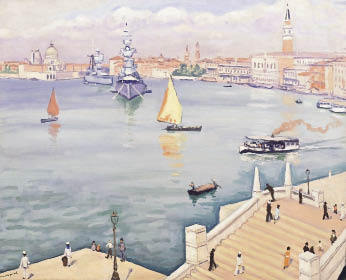Albert Marquet
Connaught Brown, 2 Albemarle Street, W1, until 26 June
Amid the usual hype about the record price achieved by an Andy Warhol self-portrait at Sotheby’s New York on 12 May, another artist’s record passed unnoticed. At the Impressionist & Modern Art sale the week before, Albert Marquet’s ‘Le Pavillon Bleu’ fetched $1.5 million.
‘Albert who?’ some of you may be asking — but when Marquet painted this picture in 1905 he was a founder member of the first revolutionary art movement of the 20th century, one of the gang of young painters in pure colours surrounding Matisse who would be branded ‘Fauves’ at that year’s Salon d’Automne. Without Fauvism, there would be no Warhol screenprints and the Pope of Pop might have remained a footnote in art history as a shoe illustrator.
It was at the Ecole des Arts Décoratifs in 1890 that the diminutive student from Bordeaux with the pebble lenses, the gimpy leg and the mordant wit met the older, more sophisticated Matisse, who became his lifelong friend and comrade-in-arms against the Institut. They progressed together to the Beaux-Arts, where they were taught by Gustave Moreau, and copied paintings side by side in the Louvre. But Marquet’s preferred school of art was the street. His schoolboy habit of bunking off to the Bordeaux docks to draw stayed with him; under his leadership, parties of truants from the life room took to the streets in pursuit of ‘anything that moves’. If a subject moved too far, Marquet gave chase with his sketchpad; some people laughed at him, others hurled abuse.
The two marvellous drawings in Connaught Brown’s new Albert Marquet exhibition — the first since Wildenstein’s 25 years ago — prove the abuse was worth it. The dozen oil paintings give little hint of his Fauve origins — by the time he painted the earliest, a brooding image of ‘Blackfriars Bridge’ (1907), that phase was over. What makes them distinctive is their disarming mix of sophistication and naivety. Marquet’s art is like a tailored coat worn by a tramp, rough around the edges but retaining its cut. His paintings have both linear and aerial perspective; their unfussy handling masks a fine control of colour and tone. But they rely for animation on things that move: boats, carriages and little black-clothed people, driven like tacks into the picture surface with single brushstrokes as if to nail the composition down.
Marquet was a rover. As soon as his pictures started selling (before Matisse’s), he travelled — a chart of his peregrinations around the Mediterranean Basin and beyond to Britain, Germany, Russia and Scandinavia looks like the route-map of a low-cost airline. His eternal quest was for the hotel room with the harbour view from which he could catch the action undisturbed.
In Venice, representing France at the 1936 Biennale, he traded down from the Danieli to a family pensione on the Riva Degli Schiavoni, from which he painted a series of almost identical prospects bounded by the Dome of the Salute on the left and the Campanile of St Mark’s on the right. His interest, though, was not in the architecture but in the Venetian basin as a container for changing light and passing traffic. In the painting in this show, two surprisingly modern warships intrude on the sunny calm of the scene, their masts setting up unnerving echoes with the Dome and the Campanile. But most of the harbour scenes here were painted in Algiers, where Marquet holed up during the second world war. In the torpid inaction of ‘Le Paquebot’ (1941–2), with its oily water blending with a milky sky, you sense the ennui of the enforced exile for whom sitting on the dock of the bay is no longer fun.
Marquet survived the war by only two years, long enough to welcome the river traffic back to the Seine and to refuse an invitation to join the Institut. His last paintings were of the Pont Neuf under snow from the window of the fifth floor apartment he had chosen for the view: ‘A spring from which I won’t be profiting,’ he regretted on his deathbed.






Comments